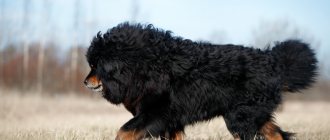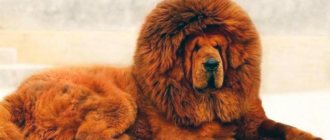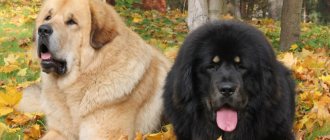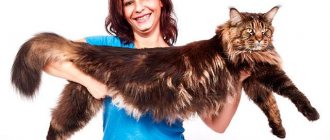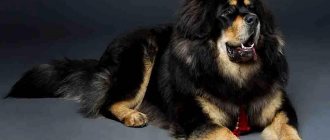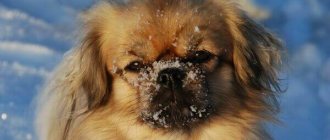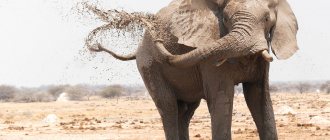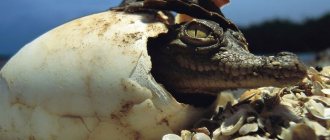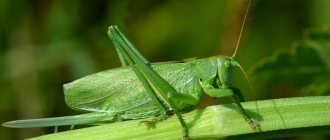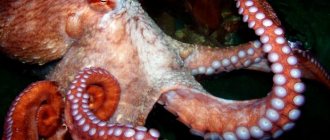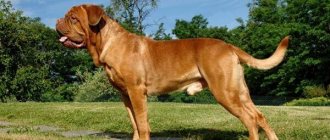Mastiffs are the name of a group that includes a large number of breeds.
It includes such varieties as Major, Spanish, Brazilian, Neapolitan, Pakistani, South African, English and other mastiffs.
The Tibetan Mastiff is one of the earliest dog breeds.
Previously, these animals were used to guard herds of sheep and houses.
In addition to having an interesting history, these dogs have an impressive appearance and are quite large in size.
The record holder for its size was a dog named Hong Dong.
History of the origin of the breed
Assyrian mastiffs are the ancestors of today's dogs. In ancient times they were used as watchdogs. Often Babylonian and Molossian mastiffs became protectors of livestock from predators. Dogs gained popularity hundreds of years BC in Asia and Europe. The breed became famous in Rome when it was brought from Great Britain to participate in dog fighting.
This breed of dog was also used as a living weapon in wars. It is believed that one mastiff is equal in strength to two legionnaires.
There is an opposite version of the origin of the dogs of the breed: they were brought from Rome to Great Britain by legionnaires and Phoenician travelers.
Historical reference
The Tibetan Mastiff is still one of the rarest breeds, although it has been known for quite a long time. Mentions of this majestic dog are found already in the 12th century in the Chinese book Shu King. Ancient mastiffs were used to hunt wild animals, particularly lions and buffaloes, and as fighting dogs. In ancient Assyrian bas-reliefs there are stone images resembling huge Tibetans.
The first European to see and describe the breed was Marco Polo in 1271. His baton was taken over in 1774 by Robert Boclet. The animals themselves came to Europe only in the 19th century.
Over time, the breed is becoming increasingly popular and in demand. This is not surprising, since the Tibetan Mastiff is a truly unique breed, which has a lot of undeniable advantages that distinguish it from other large breeds.
Description
Over time, little remains of the fierce fighting dogs of antiquity. Today's mastiffs are good-natured dogs with a high level of intelligence, calm. They are completely devoted to their owners if the environment is quiet. The dog behaves peacefully, but if it feels threatened by its owners, it will defend them to the last. At the same time, it doesn’t have to bark or growl, just the menacing appearance of the dog is enough.
According to the breed standard of the International Canine Federation, the external characteristics of the mastiff are as follows:
- The head is large, the forehead is flat with pronounced brow ridges. The massive lower jaw, tongue and mouth are pink, and the nose is large and flat. The eyes are relatively small in size, often light brown or brown in color. The ears are medium-sized, narrow, and when calm are pressed to the cheekbones.
- The neck is powerful, arched, of normal length.
- The body is massive and dense. The back is large and flat.
- The tail is full at the base, narrower towards the end. In a state of rest it is lowered, in a nervous state it rises, but not higher than the level of the back.
- The coat is short and lies tightly throughout the body.
- The color can be: deer (sometimes silver, dark), red or brindle. The ears, eye sockets and muzzle are black in any variant.
- Dog dimensions: height at least 75 cm, weight at least 70 kg.
Distinctive features
All representatives of the Molosser section have similar typical features: a large, heavy body, a wrinkled muzzle, a wide skull, well-developed muscles and strong bones. There are 8 main types of Mastiffs and many similar breeds belonging to this section and group. A separate standard has been compiled for each type, but several general characteristics are distinguished.
- The head is square in shape with a strong angular skull, pronounced brow ridges and cheekbones;
- The muzzle is of medium length or shortened, can be upturned, and is always abundantly surrounded by wrinkles. The lips are soft, often jagged.
- The body is strong, voluminous, harmonious. The top line is straight, the bottom line is tucked in, but not completely.
- The limbs are strong, smooth, parallel limbs with large rounded paws and arched toes.
Kinds
There are several variants of the breed, each of which has its own special qualities. But all varieties share two features in appearance: a large mouth and sagging skin on the face.
There are the following subspecies of the mastiff breed:
- English.
- Neapolitan.
- French.
- Brazilian.
- Spanish.
- Japanese.
- Bullmastiff.
- Tibetan.
- Mayorsky.
- Iberian.
There are also unrecognized types of the breed:
- Alpine - very similar in appearance to St. Bernards, considered extinct.
- Pakistani - dogs at the withers can be up to 110 cm high. The breed is becoming popular, but is not yet officially recognized.
- Russian - the animal calmly tolerates Siberian frosts.
- The Argentine is a large individual and is easy to train.
- Belgian - outwardly resembles French mastiffs, and was bred from them. Today this is one of the rare specimens.
- The Korean is a strong dog that has lost its popularity due to the daily painstaking care of its skin.
- Danish - There is a legend that these dogs accompanied the Vikings, and are the ancestors of today's watchdogs.
- German – bred for hunting wild boar and deer. This variety is also called the Great Dane or the Danish Hound.
- Turkish - malakly.
Newfoundland (weight – 60-70 kg, height – 69-75 cm)
These dogs are often called divers. It must be said that strong and friendly big dogs from the Canadian island of Newfoundland are welcomed all over the world. The advantage of this breed is the complete absence of aggression and hunting instincts. These dogs cannot offend either humans or animals.
It's all about what qualities of animals were in demand in the harsh conditions of the island. Dogs with webbed feet and water-repellent coats are good swimmers. Strong dogs help people pull nets, transport cargo, and even navigate the sea. Long service to people has taught Newfoundlands a certain independence; the dogs are excellent at making decisions in extreme situations. The breed has proven to be a good companion and assistant to humans; Newfoundlands get along well with children, thanks to their endless patience.
Newfoundlands were also included in the Guinness Book of Records as the strongest dog. In 1979, Barbara Alles' dog Dark Hans, weighing only 44 kg, was able to pull a cart with a load of 2 tons.
Behavior and skills
Such dogs are phlegmatic by nature, an active lifestyle, constant games and obstacle racing are not for them. As children, they like fun, but as they get older, they prefer to lie down, especially somewhere on a hill, and observe the environment. In case of danger, they are ready to fight, defend their loved ones and their property with special zeal.
Expert opinion
Anna Abramenko
An avid dog lover. Experience in veterinary medicine since 2009.
Ask a Question
This breed has herding skills, in which at the genetic level there is a desire to monitor and protect.
Dogs have skills for watchdogs: in addition to observation, restraint, and enormous strength, they are able to easily jump over a fence thanks to their powerful hind legs. This feature allows them, if necessary, to catch, for example, a runaway thief.
The above skills are a description simultaneously for all types of the mastiff breed.
Nurseries
It is better to purchase a dog in special nurseries; they are located both in Russia and abroad.
Among them are:
- "Grand Encore" in Moscow. On the website you can see photographs of adult dogs. Those interested come and meet the puppies. They can be reserved for purchase. Staff help care for their graduates.
- "Giant Pets" in St. Petersburg. In addition to the Tibetan, the Spanish Mastiff and Maine Coons are bred.
- "Bral ma" in Kyiv. The small nursery has been working with the breed since 2007. Employees monitor the health of pets, all of them comply with international standards.
- Eurasian Association of Tibetan Mastiffs in Nilüfer. This is a small Turkish nursery that started operating in 2022.
Character and appearance
English Mastiff
They have a reserved disposition, treat strangers with great attention and caution, and are non-aggressive dogs. They do not like to bark or howl in vain, they are very silent.
Representatives of the English version of the breed cannot stand quarrels; if the owners begin to quarrel, the dogs stand between them in an attempt to reconcile.
These four-legged pets, despite their menacing appearance, are gentle and sensitive dogs. You cannot treat them rudely or raise your voice; such behavior can lead to the animal becoming cowardly or, conversely, aggressive.
Such dogs get along with children and are tolerant of other animals, but if you want to get another dog, it is better to take a representative of the opposite sex.
Although these animals do not require special attention and an active lifestyle, they are not suitable for elderly people. Owners of the breed must have physical strength to cope with it.
English dogs have short fur with a thick undercoat; there are several color options based on origin: apricot, brindle or fawn.
Males can reach a height of 80 cm, and females – 70 cm. Maximum weight – 100 kg.
Neapolitan
This subspecies of the breed is not familiar with fear, has developed mental abilities, and is quite independent. Dogs are somewhat slow, they love their owners very much, but they are still strong-willed and have a strong character.
The Mastino Neapoletano is not suitable for the role of the first dog in a person’s life, nor for families with small children. They are unable to fully control their power and may accidentally harm younger family members. And with older people, in principle, they are playful, but they do not know how to distinguish comic fights from real ones and can stand up for children when it is not necessary.
These dogs are great for the role of guards and protectors. In the absence of their owners, they guard the territory with all responsibility and aggressiveness. But at the same time, they show almost no malice towards people whom the owners themselves invited into the house. Dogs may become wary only if these people begin to disrespect their owners or property.
The Neapolitans owe their origin to the Roman mastiffs, a description of which was compiled by the Roman agronomist Columella in the 1st century. n. e.
Possible colors of the breed:
- the most common: gray (sometimes with a leaden tint), black;
- less common: fawn (sometimes with a red tint), brown.
Height at the withers for males is 65-75 cm, for females – 60-68 cm. The weight of both sexes is from 50 to 70 kg.
French
These dogs are also sometimes called Dogue de Bordeaux. This name is connected with the fact that the breed was first presented at a dog show in Bordeaux in the 19th century. Dogs have high intelligence and genetically inherent nobility, despite their slowness and stupid appearance. In case of urgent need, they can stand up for themselves and their owner.
This individual gets along well with small children, is able to endure all pranks, and loves to play. You can leave your child with this type of breed and not worry, because the dog will not harm anyone, but, on the contrary, will protect and protect him. These animals have difficulty withstanding loneliness, are very sociable, and become strongly attached to their owners.
They are excellent guards and moderately aggressive. They will not make noise just like that; they are capable of showing the enemy with their appearance alone that they should not enter their territory.
The coat color is only red, of various shades (golden, fawn); sometimes there are dogs with a black mask on the face or white spots on the chest and paws.
The maximum height of representatives of both sexes is 70 cm. And the weight can reach 90 kg.
Brazilian
Fila Brasileiro is rightly called the best guard in the world. Dogs are quite negative towards strangers, but quickly respond to the owner’s command and calm down. Aggressiveness is genetically inherent in them; even at exhibitions, judges do not touch this dog.
The Fila Brasileiro needs an experienced owner who is aware of and takes into account the characteristics of this subspecies of the breed.
Brazilian dogs are submissive to their owners and strive to protect even other pets with all dedication. This is a good dog for the family, but it is worth considering that it does not tolerate strangers. It is rare that a Fila Brasileiro will trust and calmly treat a stranger.
The color of Brazilians can be monochromatic (the same shades as the subspecies described above), while dogs with brindle coloration can have light or dark stripes. Sometimes there are dogs with a black mask on the face and white spots on the paws, chest and tip of the tail.
The minimum weight of dogs of both sexes is 40-50 kg with a height of 65-75 cm for males and 60-70 cm for females.
Spanish
In the past, these dogs were excellent shepherds. Thanks to their stable psyche and developed mental abilities, they could monitor livestock in the mountains without water or food, and return the herds safe and sound.
Selfless dogs are so devoted to their owners that they can sacrifice themselves for them. For all their formidable appearance, they are affectionate and loving, get along with children, take care of them, and monitor their safety.
The most common colors of this breed are yellow (any shade from light to dark), black and brindle.
The minimum height for males is 77 cm, for females - 72 cm. Weight is approximately 80-85 kg.
Japanese
This subspecies of the breed is also not suitable for the role of the first dog. Despite the balance and prudence, high level of intelligence, such an animal needs an owner with a persistent, strong character. The breed has a well-developed guard instinct and is able to protect its owners to the last. The dog is skeptical towards strangers, if there are no aggressive manifestations on the part of the stranger, then there is a chance to even make friends with it. Mutual respect between humans and animals plays an important role.
Tosa Inu are aggressive towards other dogs and pets. The exception is those with whom they grew up.
If the owner manages to gain authority from the animal, then it will be completely devoted to him and become a loyal friend and protector. Tosa Inu are also phlegmatic, but only until they sense negativity.
The height of dogs of both sexes can reach 75 cm, and weight – 60-70 kg.
The color is varied: brindle, red, black or fawn. There may be white spots on the chest and paws.
Bullmastiff
From the name it becomes clear that this type of breed is the result of crossing English mastiffs with Old English bulldogs. The dogs were bred to protect gamekeepers from poachers; for some time these animals were called the “night dog of gamekeepers.” They had the skills to help them track and apprehend violators in the forest at night.
In general, these dogs are not prone to aggressive outbursts, but it is still worth being vigilant. They are so loyal to their owners that they are capable of killing their enemy in defense. Such animals treat acquaintances and family friends neutrally, but treat strangers with wariness and attentiveness.
Bullmastiffs get along well with children and other pets, but it is still better not to leave them alone with him.
The height of the dog at the withers can be 63-69 cm for males, 61-66 cm for females. Weight is 41-59 kg.
The color is found in the same colors as other types of the breed.
Tibetan
Such dogs have an independent character and may not obey their owners if they are confident that they are right. They have a negative attitude towards violating the boundaries of personal space, and do not like familiarity on the part of the owners’ acquaintances and friends.
Expert opinion
Anna Abramenko
An avid dog lover. Experience in veterinary medicine since 2009.
Ask a Question
These individuals are not suitable as the first pet in a person’s life, or for families with children. They may react with anger to a child's crying, mistaking it for aggression towards them. They can have normal relationships with other pets only if they grew up together.
Initially, the breed was bred in India, Nepal and China to protect flocks of sheep from attacks by leopards. The dogs have retained their protective qualities to this day.
The height of males is 66-77 cm, and that of females is 61-70 cm. Representatives of this breed weigh approximately 60-80 kg.
This is interesting: Education and training of Tibetan mastiffs
The coat of dogs is thick and very lush, and the color can be black, brown, golden or gray.
There is a legend that the white markings on the chest of dogs are a symbol of a brave heart, and the spots above the eyelids represent an additional pair of eyes, which helps to look into a person’s soul and find out everything secret.
Mayorsky
At home, Ca-de-Beau dogs are the most common dogs and love small children. They do not show aggression for no apparent reason.
Males can reach 55-58 cm in height and 35-38 kg in weight. Females – 52-55 cm and 30-34 kg.
The coat is short and coarse, and comes in the same colors as other representatives of the breed.
Iberian
This species gives the impression of an angry and strict dog, in general this is true, but only to outsiders. Such animals are kind and caring towards family members and are excellent nannies for small children. Affectionate, peaceful individuals become strongly attached to their owners.
The minimum height for a male is 81 cm, for females – 75 cm. Average weight is 70 kg.
Dogs have thick fur. The color is always white with a mask on the face of the same shades as the spots on the body (gray, yellow, brown, black).
Briefly about the main thing
- Mastiffs are not ordinary dogs. They must be brought up with a balance of severity and praise.
- The specific appearance looks scary. Massiveness complements the “scary” image.
- A distinctive feature is the specific structure of the body with a developed sternum and prominent muscles.
- Among the representatives of the breeds there are those with short or long thick hair.
- Most mastiffs have numerous folds of skin, especially on the face.
- Buying and keeping a dog is an expensive business. It is important for her to maintain physical fitness by providing quality nutrition and long walks.
- Suitable for lovers of an active lifestyle with canine experience.
- The dog is devoted to his family and is almost devoid of aggression. When in danger, he attacks first.
- Gets along well with children, takes care of the kids, and perceives the family as his own pack.
- Historically, they descended from ancient dog breeds for which it was important to be close to people.
Education and training
From the moment a dog appears in a family, it is important to let it know who is boss. You cannot use force, otherwise you can intimidate the animal. The relationship between him and the owner must be trusting and respectful.
Education and activities should bring pleasure to the owner. If you don't pay enough attention to your pets, they will begin to suffer.
It is important to take into account that this breed is slow - you should not insist on excessive physical activity, otherwise, you can cause irreparable harm to the dog, especially in puppyhood.
Mastiff training is a complex process. For it to succeed, you need to have willpower and leadership qualities. A good age to start training a dog is 8-9 months. It is advisable to conduct the first training sessions in the presence of an instructor; in the future, owners will be able to cope at home.
Expert opinion
Anna Abramenko
An avid dog lover. Experience in veterinary medicine since 2009.
Ask a Question
Training should be daily: repeating already learned commands, learning new ones. This is especially necessary for dogs that are being prepared for exhibitions.
It is advisable to take care of pets whenever and wherever possible; they need constant development. If an older dog is purchased, it must be taken into account that it will need time to get used to its new owner and environment.
Each dog needs an individual approach, these animals are unique. And if the future owner doubts himself, then it is better to turn to specialists or not to purchase a purebred animal at all.
Features of training
Dogs are highly human-oriented and require training, early socialization and discipline. The future owner who decides to get this dog must be prepared to spend a lot of time on training and education. If this is not done, the pet will take on the role of leader and become uncontrollable. Thanks to a competent approach, the dog will get rid of excessive suspicion of strangers.
The Tibetans are formidable guards and anyone who enters their territory will face trouble. This should be taken into account by owners choosing a puppy of this breed.
It is important to accustom your pet to unquestioning obedience from puppyhood; later this will help control the actions of the furry giant.
For fruitful learning, it is important to choose the right tactics - be patient but firm, show determination, but do not forget about affection and praise. A well-bred dog will not cause any inconvenience, will understand commands perfectly, and living together will be comfortable
It is necessary to start training at an early age. The education algorithm consists of 3 stages.
- Imprinting. Essentially, this is teaching the puppy to trust. During simple exercises and actions, the four-legged pet learns not to be afraid of upright creatures and begins to trust them.
- Socialization. The second stage of upbringing is an integral continuation of imprinting. It consists of walking the puppy daily, which allows you to get acquainted with the world around you, learn about other representatives and other inhabitants of the urban or suburban fauna. Early socialization is the key to adequate behavior of Tibetans towards other animals and humans.
- Study of OKd. A general training course allows you to teach your dog to follow basic commands. So that the owner can control the dog even in the most unforeseen situations.
If the dog does not show diligence and is not inclined to absorb knowledge like a sponge, it’s okay. Innate leadership slows Tibetans down a bit, but over time they accept the owner as the head of the family. Provided that he demonstrates leadership qualities, he does not allow himself to use physical force on the pet.
Care and maintenance
Despite their large size, these dogs are unpretentious. They adapt to conditions without much difficulty. Tibetan mastiffs are the most difficult to keep because of their long hair, but at the same time they are the only ones capable of living outside all year round. Other representatives of the breed have short hair and some have to wear warm overalls in winter.
Before buying a puppy, you need to prepare the house. Purchase all the necessary accessories (toys, bowls), place the bed in a warm place without drafts and humidity. After purchasing, it is important to raise the plates to a comfortable height for the dog.
Every day it is necessary to examine the animal’s eyes for inflammation, and wipe the mucous membranes with chamomile decoction every 2 days. Ears should also not be neglected and should be cleaned as needed. For teeth, you can purchase special chewing toys for cleaning, or you can rinse your dog’s mouth with toothpastes yourself. Nails do not need to be trimmed often, only if necessary, and paws should be washed regularly, after every walk.
It is important to treat dogs for fleas and ticks using special shampoos or collars. Long-haired Tibetan representatives of the breed should be combed 3 times a week, and in the summer it is better to cut them. Mastiffs shed once a year.
Pets do not require frequent and active walks, but they need walks of 1.5-2 hours a day to prevent obesity. A leash is required, as the breed is large and can accidentally harm someone. Dogs are taken outside for the first time at 2-3 months of age, after all vaccinations.
Mating
Depending on the pedigree of the dog, mating can be either regular or breeding. If pedigree documents have been created for animals, then mating must be carried out on an official basis. The girl's owners must request a special certificate from the nursery and find a mating cable. The time and date of mating should be discussed in advance.
Mating is carried out only after the female mastiff reaches the age of 2 years.
- At 8-10 months, the first heat will begin, but at this period she is too weak to bear puppies. The process itself should be planned for the 15th day of the third heat period, when the girl begins to have light and bloody discharge and the loop swells.
- Mating this breed requires a lot of space, so the space where the process will take place should be prepared in advance. To get to know each other, you can take your pets out for a walk together so that they can get to know each other and sniff each other.
- When the mastiff boy mounts, you should help the animals continue mating.
- The girl is supported under the stomach and by the head, and the cable is directed into the loop. This is done to ensure that the animals are not injured in the process.
- The lock together with sexual intercourse lasts about 20 minutes .
- The next mating should be repeated after 2 days .
Nutrition
Although mastiffs are massive dogs, they do not need large portion sizes. The number of meals for puppies is 5-6 per day, and by older age, it is reduced to once a day (in the evening). If the choice falls on dry food, then it should be grain-free, intended for large breeds, and the serving size for an adult dog should be 800 g.
Individuals of these species need a large amount of meat (beef, chicken or rabbit). The following is a table with permitted and prohibited foods for dogs of this breed.
| Can | It is forbidden | ||
| Kefir | Butter | ||
| Cottage cheese | Citrus | ||
| Milk | Onion and garlic | ||
| Boiled sea fish without bones | Pork meat | ||
| Rice cereal | Cooked with water, milk or broth | Potato | And other vegetables and fruits with starch |
| Buckwheat | Melon | ||
| Oatmeal | Floury, sweet | ||
| Fruits | Raw | Bones | |
| Vegetables | Fried, salted, smoked | ||
Expert opinion
Anna Abramenko
An avid dog lover. Experience in veterinary medicine since 2009.
Ask a Question
You should not feed dogs leftover food or table scraps, as this can harm the animal. It is necessary to observe proper nutrition and its regime so that the individual develops harmoniously and has strong immunity.
Drinking water should be available to pets at all times, and bowls should be washed regularly in hot water.
Mastiff Health and Diseases
The most common problem with mastiffs is bloating because they eat and drink too quickly. This can lead to negative consequences; dogs, when bloated, lie on their backs and begin to spin and roll over, and such actions can cause injuries and sometimes lead to death. To protect the animal, it is necessary to feed it in small portions.
In addition, there are a number of hereditary diseases:
- muscular dystrophy;
- progressive retinal atrophy;
- epilepsy;
- bone cancer;
- cataract;
- retinal dysplasia;
- Wobbler syndrome;
- demodicosis;
- dysplasia of the hip and elbow joints;
- cardiomyopathy;
- hypothyroidism;
- leukemia;
- glaucoma;
- superficial pyoderma;
- myasthenia gravis.
Less common, but found:
- allergy;
- arthritis;
- pulmonary stenosis;
- hernia.
Due to the large number of hereditary diseases, it is important to carefully consider the choice of a breeder or kennel when purchasing a puppy and the health of the dog in the future.
Lifespan
The data shown in the table below is approximate. The lifespan of any dog depends on the owners, how well they care for the animal and feed it properly.
| Breed type | Term |
| English | 6-10 years |
| Mastino neapoletano | 8-9 |
| Dogue de Bordeaux | 8-10 |
| Fila Brasileiro | 9-11 |
| Spanish | 10-11 |
| Tosa Inu | 10-12 |
| Bullmastiff | 8-10 |
| Tibetan | 12-16 |
| Mayorsky | 10-12 |
| Iberian | 10-12 |
Pros and cons of mastiffs
Breed types have a common set of advantages and disadvantages.
Pros:
- fearlessness;
- loyalty to the owners;
- calm temperament;
- caring and affectionate attitude towards loved ones;
- The dog does not easily cope with the change of owner.
Minuses:
- independence;
- such an animal cannot easily endure loneliness;
- some species are prone to aggressiveness;
- the coat of Tibetan mastiffs requires constant care;
- profuse salivation.
Rules for choosing puppies
First you need to familiarize yourself with the rules for keeping large breed dogs and determine whether everything complies with them. And also, first of all, it is advisable to get acquainted with an adult representative of the breed and observe his behavior. The puppies look very cute and attractive, it’s hard to resist buying such a cute creature. But if people fail to cope with upbringing or cannot provide the proper conditions, then the pet begins to suffer.
Expert opinion
Anna Abramenko
An avid dog lover. Experience in veterinary medicine since 2009.
Ask a Question
You should never rush, you should visit several exhibitions or clubs, get acquainted with as many dogs of the breed as possible in order to finally make sure that it is the one you should buy.
It is worth considering that some of the animals can dig up or break down fences and run away; it is advisable to think about organizing a safe area where the dog will be alone. And also the fact that all representatives of the breed drool profusely, which has a destructive effect on the polishing of furniture.
When deciding on the gender of your future pet, it is of great importance that mastiff bitches have a very difficult time giving birth and they are picky in choosing a male. This information is especially important for those people who plan to breed the breed.
Popular nicknames
| Floor | Nicknames |
| Male | Bojing (delighted by victory), Weizh (great sage), Weiming (bringer of greatness), Gang (prosperity), Jinhei (golden, sea), Kiang (strong), Lei (thunder), Ling (compassionate), Rong (military), Fang (honest), Heng (eternal), Shining (peace), Shen (cautious), Enlei (benefits), Yusheng (decisive) |
| Bitch | Aimin (people's love), Bao (lovely), Jia (beautiful), Zhilan (rainbow orchid), Kiang (rose), Xia (pink clouds), Lijuan (beautiful, graceful), Mingzhu (bright pearl), Ruolan (orchid-like) ), Chongtao (spring peach), Shihong (beautiful world), Shuchun (fair purity), Yuan (bright world), Yuming (jade brightness), Yan (swallow) |
Puppy cost
The price of a baby can vary from 25 to 100 thousand rubles.
Approximate amounts you will have to pay for a puppy:
- English – 40-100 thousand rubles.
- Neapolitan - 50-60 thousand rubles.
- French – 30-85 thousand rubles.
- Brazilian – 30-70 thousand rubles.
- Spanish – 35-100 thousand rubles.
- Japanese – 80-130 thousand rubles.
- Bullmastiff – 25-50 thousand rubles.
- Tibetan – 30-100 thousand rubles.
- Major and Pyrenean - 25-40 thousand rubles.
Interesting facts from the life of dogs
- The English mastiff Zorba is recognized as the largest dog of the breed; his weight reached 156 kg. The dog is natural and not associated with obesity or other health problems. None of the representatives of the breed has yet been able to break this record.
- There is another massive dog - Mastino Neapoletano Hercules, his weight is 128 kg.
- The Neapolitan Mastiff can be seen in the Harry Potter films; the role of Hagrid's dog, Fang, was played by a representative of this breed.
- The Dogue de Bordeaux was popular in the 1990s; he also appeared on television as the dog of the famous Sasha Bely, the main character of the TV series “Brigada”.
- The Dogue de Bordeaux is also found in the film Turner and Hooch. After watching this film, you can conclude what kind of dog it is.
- Not so long ago, the living conditions of Spanish mastiffs were quite difficult, and therefore only four puppies were left from litters. It was believed that a bitch could only feed so many babies. And when they stopped feeding on their mother’s milk, their owners fed them very poorly, so that during the period of skeletal and muscle development they would not injure themselves with excess weight.
- Among the Tosa Inu there is a record holder dog; in weight pulling (a sport of moving loads with four-legged animals), a representative of the species was able to move a weight of 1585 kg.
- Tosa Inu is very rare even in its homeland. Since 1991 it has been on the list of prohibited dogs in England due to its temperament.
- The voice of Tibetan mastiffs is considered sacred by the inhabitants of their homeland, and pets occupy a place of honor in the culture of these peoples.
- In the 19th century in England and Germany, Tibetan dogs were kept in zoos as strange animals.
Color variations
In general, the family has a wide range of coat colors.
The main shades are:
- deer;
- apricot;
- black and tan;
- grey;
- brindle;
- ginger;
- white with spots.
Apricot and fawn colors are characteristic of English mastiffs, but a mandatory condition for them is the presence of a black mask on the face.
Bullmastiffs also have a dark mask, with the rest of the body being a solid color . Any shades of brindle, fawn or red are allowed
Gray, lead gray and black colors are characteristic of the Neapolitan. Black coloring and red or other tan colors can be seen in Tibetan Mastiffs.
Pyrenean Mastiffs are primarily white with black markings . The fawn color is characteristic of Spanish Mastiffs.
The blue shade of Neapolitan is considered quite original. Also available in mahogany and isabella colors.
Reviews
Bogdan: “My first dog in my life is a Tibetan mastiff. I was looking for a suitable four-legged dog to guard the house, thought for a long time and finally decided. I don't regret it at all. Her psyche is reinforced concrete, she never reacts to small animals that are always barking. She was never the first to get into a fight. She’s very smart, you don’t need to repeat every day what’s possible and what’s not.”
Alice: “At one time I had an English Mastiff dog, it was the best animal in the world. From puppyhood she was calm and quick-witted and coexisted well with a cat. It was funny to see how kindly Jessie treated her. My daughter was constantly pulling the dog’s ears and throwing a ball, but Jessie just loved it, she was happy to babysit the child.”
Ekaterina: “The whole family fell in love with the Dogue de Bordeaux when we saw it. The decision was immediately made - let's take it! This is the kindest dog in the world, although it seems dangerous and formidable. We have our own home, and Dora does an excellent job of guarding it, doesn’t bark in vain, doesn’t rush at anyone.”
Any mastiff is a wonderful guard and watchman. These are kind, intelligent animals that need affection and care. It doesn’t matter which type is chosen, everything depends only on the owners. How you can raise and train a dog, that’s how it will become.
How sensitive guards and loyal family friends won the recognition of humanity
Many countries and peoples have written their pages in the history of the appearance and further spread around the globe of the large Tibetan mastiff.
Chinese scientists who conducted genetic research in the field of separating the DNA chains of a wolf and a dog made the assumption that the process occurred more than 40,000 years ago; the approximate “date of birth” of the breed of interest to us is considered to be a period of more than 50,000 years ago.
The conclusion suggests itself: Tibetan giant dogs are one of the first dog breeds on the planet. The Mastiff's "closest relatives" are the Great Pyrenees, Bernese Mountain Dog, Rottweiler, Saint Bernard and Leonberger.
The ancestors of these breeds quite likely had passionate affairs with each other, which was the reason for the appearance in the future of these well-known large pets.
Throughout the history of mankind, Tibetan Mastiff puppies have become a generous gift or trophy for the winners of certain battles.
The victorious march of the unique breed across the planet began back in the 10th century (it was at this time that the first writings about the unusual family of dogs appeared) and continues to the present day.
A major role in the spread of mastiffs around the world is given to the ubiquitous Romans, great lovers and connoisseurs of the dog breed. The Roman legions, roaming the planet in order to conquer territories and establish their dominance, became the unwitting reason for the first timid appearance of the breed in Europe.
Officially, Western society became acquainted with the Nepalese and Indian guards in 1847, when the English aristocrat Lord Harding presented Queen Victoria with a magnificent male of the Tibetan breed named Siring; this moment became key in the process of spreading mastiffs across the European continent.
Giant dogs came to America a little later, first as a gift to President Eisenhower, then through mass importation from the heavenly lands.
Photo and video
In this section you can familiarize yourself with the appearance of each type of breed. Thanks to the presented photos and videos, you can roughly estimate the size of the animal.

